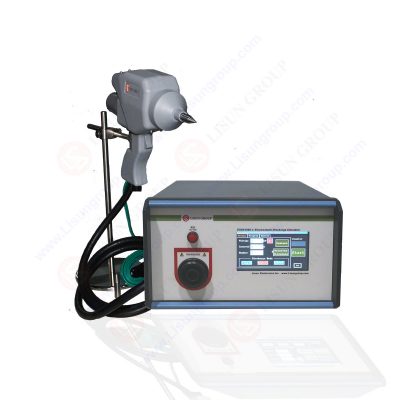
An Electrostatic Discharge (ESD) generator is a testing device designed to simulate electrostatic discharge events. They play a crucial role in electronic device testing, aiding engineers in evaluating and improving equipment’s sensitivity and tolerance to electrostatic discharge.
Introduction
ESD generators are designed according to international standards like IEC 61000-4-2 to simulate electrostatic discharge events, ensuring testing consistency and repeatability. Typically, they consist of a high-voltage power supply, control circuitry, discharge circuit, and trigger mechanism.
Operation Modes
ESD generators offer various operation modes to meet different testing requirements and user preferences:
• Manual Mode: In manual mode, operators directly control the discharge of the ESD generator through physical buttons or switches. This mode is suitable for simple testing scenarios, providing intuitive and flexible operation.
• Automatic Mode: In automatic mode, the ESD generator automatically discharges based on preset programs or external signals. This mode is suitable for scenarios requiring high repeatability and consistent testing steps, reducing errors from manual operation.
• Remote Control Mode: Remote control mode allows remote operation of the ESD generator via a computer or dedicated control unit. This mode is suitable for operating equipment at a safe distance or integrating into automated test systems.
• Software Control Mode: In software control mode, users can program and control discharge parameters of the ESD generator using dedicated software. This mode offers high flexibility and precise control, suitable for complex testing requirements.
• Sequence Mode: Sequence mode allows the ESD generator to automatically execute multiple discharges according to specific sequences and time intervals. This mode is useful for simulating a series of consecutive discharge events, improving testing efficiency and consistency.
ESD61000-2_Electrostatic Discharge Simulator
Discharge Modes
Discharge modes define the discharge characteristics of the ESD generator, including discharge voltage, duration, polarity, etc. Common discharge modes include:
• Contact Discharge (CD): CD mode simulates electrostatic discharge generated by direct contact with the Device Under Test (DUT). It ensures a clear discharge path and is typically used for testing devices with smooth and conductive surfaces.
• Air Discharge (AD): AD mode simulates discharge across small air gaps above the DUT. It models electrostatic discharge in non-contact environments and assesses devices’ immunity to interference.
• Charged Device Model (CDM): CDM mode simulates complex electrostatic discharge scenarios encountered during actual device usage. It considers static electricity phenomena resulting from contact and separation of different materials during device operation, providing testing closer to real-world application environments.
• Field Induction Mode (FIM): FIM mode simulates electrostatic discharge induced by strong electric fields near the DUT. It is mainly used to evaluate devices’ electrostatic interference resistance in strong electric field environments.
• Pulse Width Modulation: Pulse width modulation simulates electrostatic discharges of different durations by adjusting the width of discharge pulses. It tests devices’ responses and tolerance to electrostatic pulses of different durations, providing a comprehensive assessment of electrostatic resistance.
Operating Procedures
When operating an ESD generator, follow these steps to ensure accurate and safe testing:
• Set Parameters: Set voltage, pulse width, polarity, etc., according to testing requirements. Ensure parameters comply with test specifications and device requirements.
• Calibrate Equipment: Regularly calibrate the ESD generator to ensure its discharge characteristics meet standards. Calibration can be performed using professional calibration equipment or services to ensure the accuracy and consistency of test results.
• Prepare DUT: Ensure the Device Under Test (DUT) is in the appropriate testing state, including but not limited to:
Powering on the device (if required for testing).
Placing the device in the designated test position and environment.
Connecting all necessary test instruments and monitoring devices.
Execute Discharge: Perform discharge in the selected operation mode. Choose from manual, automatic, remote control, software control, or sequence mode based on specific testing requirements. Observe the DUT’s response and record any abnormal phenomena during discharge.
• Data Analysis: Collect and analyze data from discharge testing. Evaluate the DUT’s ESD performance, including sensitivity and tolerance to electrostatic discharge. Detailed documentation of test results and observed device responses is essential.
• Safety Measures: Take appropriate safety measures when operating the ESD generator, such as:
Wearing anti-static wrist straps or other protective equipment.
Ensuring operators receive proper training.
Following operational procedures to avoid errors.
Precautions
• Operational Safety: Operators should receive proper training and strictly adhere to operational procedures to prevent harm to personnel and equipment during operation.
• Equipment Maintenance: Regularly inspect and maintain the ESD generator. Ensure its proper operation and promptly repair or replace it if problems are detected.
• Environmental Control: Conduct ESD testing in controlled environments to minimize external interference. Ensure the temperature, humidity, and electromagnetic environment of the test environment meet testing requirements.
• Testing Standards: Follow relevant international standards and specifications for ESD testing, such as IEC 61000-4-2, to ensure the reliability and comparability of test results.
• Data Recording: Thoroughly document test conditions, discharge parameters, and test results. Ensure data integrity and traceability for subsequent analysis and reference.
https://www.lisungroup.com/news/technology-news/electrostatic-discharge-esd-generator-operation-modes-and-testing-procedures.html
.jpg)
Comments
Post a Comment